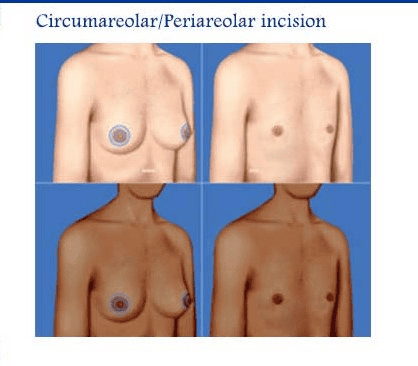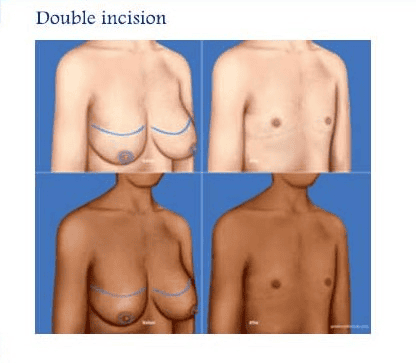Breast augmentation for transgender men (mastectomy or chest masculinization surgery) is a type of surgery to remove the breast tissue for those wishing to live authentically according to their gender identity. Furthermore, breast augmentation for transgender men can be performed as a step in the treatment for depression caused by differences in the need to express their gender and the gender identity (Gender Dysphoria). This surgery is performed by cosmetic surgery surgeons with high expertise and experiences.
How many procedures are there for this surgery?
Normally, a mastectomy surgery will last around 1 hour 30 minutes to 5 hours depending on the size of the breasts, areola, and nipple. The surgical procedures commonly applied to transgenders are: Keyhole, Periareolar, and double incision. To better understand, we can look at the illustrated photos below.


Keyhole incision
This surgery is only advised to those who have excessively small breasts (A cup), firm breast skin, and can last between 1 hour 30 minutes to 3 hours. The surgeon will make an incision extending the lower half of the areola, and completely remove the breasts through this incision.
Advantages
Small incision, so the aesthetic result is relatively high
Better ensure the sensation of the nipples compared with other procedures.
Quick surgery and recovery time.
Drawbacks
Patients with moderate to large breasts, and sagging, loose skin are unable to undergo this procedure.
Unable to resolve extensive areolas.
Periareolar incision
This surgery is applied to patients who have moderate breasts (A cup and B cup) and good skin elasticity. A round incision is made around the edge of the areola to remove the breasts. After that, a larger round incision is made to remove the excess skin. The skin is tightened to the center just like tightening a drawstring bag. Another vertical incision extends below the areola to remove excess skin when the skin is sagging. This surgery can last from 3 to 5 hours.
Advantages
Ensure sensation of the nipples in most cases.
Resolve the issue of excess skin in the areola.
The thread scar lies around the areola, so the aesthetic result is relatively good.
Drawback
Inapplicable on patients with enlarged and sagging breasts.
Double incision surgery
This surgery is usually combined with nipple-areola complex grafting and is applied to patients with large breasts (C cup and above), where the nipple-areola complex is positioned lower the inframammary fold and has significant sagging. The surgeon usually removes the skin, fat and breasts in about 3 to 4 hours. The patient’s nipple-areola complex will be detached and reshaped to resemble a male nipple-areola and grafted to a new position.
Advantages:
The skin and breasts are removed more thoroughly compared to the above methods, so it is applicable to patients with large breasts and sagging skin.
Combined with areola and nipple shaping, so the aesthetics result is relatively good.
Drawback:
Extensive scar, easy to leave unsightly marks.
Reduce the sensation of the areola and nipple.
What are the potential complications?
Like other surgeries, removing the breasts still contains potentials of bleeding, infections and adverse reactions with local anesthesia. Other potential complications including:
- Unhealed wound.
- Fluid accumulation.
- Hematoma.
- Tissue deterioration, especially nipple tissue.
- Unsightly scar.
- Unsatisfied with the post surgical result.
- Unbalance on both sides.
What do patients need to prepare before the surgery?
Chest masculinization surgery for transgenders is performed on those who are above 18 years old.
Hormone therapy is not recommended to be performed before this surgery. In some cases, waiting for the chest muscles to develop after being treated with testosterone supplementation will yield the best post surgical results. If undergoing testosterone replacement therapy, the patient will go through a blood test to check if the testosterone level is within the permittable range.
Before the surgery, the surgeon will provide the patient with various choices and results after the surgery, in addition to giving information about anesthesias, surgical areas, and any post-operative care procedures if necessary. The patient is required to follow the surgeon’s professional guidance before the surgery, including advice in dietary, quitting smoking, and adjusting the medications that are being used by the patient.
Things patients need to know before the surgery.
+ Discuss with the surgeon about the patient’s goals and desires.
+ Talk about scarring reduction techniques with the surgeon.
+ Be prepared to share your family history of breast cancer with the doctor.
+ All surgical patients should regularly check on their breasts before and after the surgery.
+ Make sure to have a breast cancer screening before the surgery.
Post-surgical recovery process
The recovery period for chest masculinization surgery varies on each individual. Those who underwent the surgery usually return to work or school after 2 weeks.
To minimize fluid accumulation post surgery, the surgeon will place a small tube on each side of the breasts so that fluid will flow out. And these tubes will be removed when the surgeon assesses that it is stable.
Day 1 and 2 of the recovery procedure are usually the most uncomfortable ones. This discomfort might be the result of local anesthesia wearing off, as well as compression bandages or surgical bras tightly holding the bandages on the incisions or grafts.
To ensure no additional pressure on the surgical site, the patient will have to lie down with face up in at least the first week after the surgery.
About 10 days after the surgery, the patient will have an appointment to remove the stitches.
The swellings will usually reduce in 2 or 3 weeks, but for some, this process can take up to 3 to 4 months.
The nipple skin after reconstruction might turn black in the early stages, but will return to normal after new skin graft. If there is swelling, redness, ulceration, or pus, the patient needs to immediately so that the doctor can treat it early.
Patients should be careful not to lift their arms above their heads for at least 2 to 3 weeks after the surgery. Movements such as arms stretching and lifting can enhance the scars. After 6 to 8 weeks, patients can usually resume exercising, lifting and running.
Post-surgical care.
Bathing is prohibited until the following check-up, when the compression bandage is removed. Soft towel and showering sponges are usually two of the best and easiest ways to clean during the recovery period.
Use ice compressing bags in the first 2 days after the surgery. Almost everyone has swellings and bruises after the surgery, but the degree of swellings and bruises varies. Ice compressing can reduce inflammation and alleviate pain.
Avoid lifting or engage in strenuous exercises. Lifting anything that weighs over 5 kg isn’t encouraged in the first 2 weeks of recovering. Patients can resume light exercises such as walking as soon as they feel well, just be careful not to do anything that raises the heart rate.
Take care of yourself: The best things you can do to speed up the recovery process is to rest, eat healthily, avoid smoking and drinking alcohol.
Use scar treating methods: Scars from mastectomy surgery can turn red in the early stages, and this phenomenon is normal for the body after wound healing. Over-the-counter scar treatments can also speed up the healing process, as well as reduce scars and redness. Patients can use silicone patches to continuously compress the wound to prevent hypertrophic scars for about 3 months. If a hypertrophic scar has formed, patients can have a check-up to receive a treatment injection from the doctor.
* The results achieved depend on each individual’s constitution.